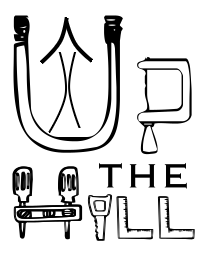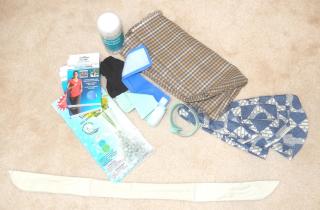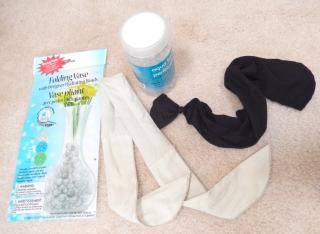









| Next Post - Previous Post List View
| |
 | 7/29/2014 3:03:05 PM Road Trip Tips |
Last week I took a semi-last-minute trip to Topeka with my niece to visit my parents. And while a toss-it-in-and-go kind of trip was the standard when I was young, as I have gotten older I have realized a few things about long car trips. For example, the fact that road trips just are not as much fun as I thought when I was a kid, and for some reason everything in the world isn't really six hours away. And sadly, my stomach is no longer made of iron and capable of downing large quantities of greasy fast food at random. So I thought I might pass on a few tips that might come in handy for those that are taking their first long-haul trip and seasoned travelers alike. The one thing that hasn't changed since I was a kid is that gas-station prices are truly frightening, and not just on the gas. I mean really... who wants to pay $1.50 to $2 for a bottle of water, and even more for a soda? $3 for a small bag of chips and $2 for a small candy bar? Not to mention the limited choices of snacks. So my first tip is... get it at a grocery store. If you plan ahead and take a cooler-bag, you can get your favorite water, soda, and snacks for a fraction of the price of gas stations. And if you happen to forget or run out, there are often grocery stores and wally-worlds much closer to your travel path than you might think. It is also much easier to make more healthy choices when you have a hundred more options to choose from. Additionally, it can help prevent dehydration and stomach upset if you have your drinks and snacks readily available instead of waiting for the next stop for gas. And of course, for those of us who have passed the age where we can eat anything at any time, it is much easier at a grocery store to find reasonably priced pretzels, granola bars, and crackers instead of falling back on potato chips and grease-burgers. Even when stopping for a fast food lunch or dinner, after saving so much money on snacks, it is easier to justify the added cost of healthier choices that will keep you feeling better the whole trip. Not that I eat salads when traveling or healthy things that I would not normally eat... that can throw your stomach for a loop as much as anything else. But sometimes a roast beef or chicken sandwich instead of a cheese burger can make all the difference in how I the rest of the day. Cooler bags vs ice-chests. While the hard-sided ice-chest is probably preferable for camping and protecting food from crushing in a heavily packed situation, I prefer a good quality cooler bag for road trips. It takes a little more thought when packing so that it is easy to reach and will not get crushed by luggage or reclining seats, but the fact that it is flexible can make it fit behind seats, in the middle of the back, or even on the passenger seat or floor when you are traveling alone. This means that you or your passengers will be able to reach it without stopping to open the trunk or re-arrange luggage. Even better is that it gets smaller as you eat or drink the items inside, and I have found them to keep items as cool as most medium quality ice-chests will. A cooler is great for winter, but what about hot trips? Yea... not many people like to drink hot soda, or water, especially on a scalding summer day. So the natural thing to go for is an ice-pack, right? But then the ice-pack melts and you have a half-dozen warm bricks of inconvenience to tote around for the rest of the trip. My preferred option is freezing bottles of water before the trip. Then as they melt, they become nice icy-cold drinks and they keep all your other snacks and drinks cool in the mean-time. A little caution should be used when freezing water bottles though since water expands as ice... open the lids, pour out an inch or so of water, then freeze the bottles up-right in the freezer and put the lids back on when fully frozen. Also, some of the cheapest bottles are very thin and not as good to use since they can crack when frozen. Grocery store brands are often too thin, but the next step up seems just fine. With a medium to good quality cooler-bag, fully frozen bottles can still be cold at the end of a full day trip through a furnace with no air-conditioning. ( Yep... just proved that last week. ) And while we are talking about heat... there is very little worse than heat exhaustion on a long trip, and even if your car has a great air-conditioner, the sun beating down on you can easily burn even the tannest of skin, and things are worse for the driver because they often can't move out of the direct sun on their arms and legs. So sunscreen is of course on the list of must-take items. However, for those of pale complexion and a tendency to burn easily, a bit more protection may be needed. Something people have a tendency not to think about is full length pants or capris, and a very light-weight cotton full-sleeve shirt in light colors. Now, how can this be better than short-shorts and a tank top you ask? Well, just think about the arabian desert... People there don't just cover themselves from head to toe to be modest. The sun is their enemy and they have found ways to protect themselves... flowing white cotton robes. Now... it might not be practical to wrap up in your best loose-fitting bed-sheet, but the more you can cover of your skin the better. And, if made of very light cotton, the cooling from keeping direct sun off your skin can easily outweigh the diminished air-flow. Depending on the season, it may be nearly impossible to find light cotton clothing at a big box store, but thrift shops almost always have a few dozen very light-weight cotton men's dress shirts in a wide array of sizes. Hubby burns very easily, so we often keep a cheap over-sized shirt in the car just for that reason. In fact, a full set of cheap sun-protection clothes is easily able to fold into a small bag and can be kept in your car's emergency supplies. And of course, it has the added benefit of being there if you spill something on you while driving around town. I am usually dealing with a different heat issue though. I am tan enough not to burn easily (though I still often wear capris and a sleeved shirt on trips), but I am over-sensitive to heat itself. Probably from getting fully into the range of heat-exhaustion way too many times when I was younger and living in several excessively hot and/or humid places. It was miserable but manageable when I was young, but along with metabolism and energy, my ability to handle heat has waned with age. I don't live in the mountains just because I am a hermit. So even on day-trips down into Denver in the summer, I try to always remember to take a few cooling bands. Of course, it isn't something most people would need if they had air-conditioning, or even just a decent tolerance of heat on a short trip, but even if you have no trouble with heat at all, a long driving trip can be awful with no AC in the summer.  And that brings me to cooling bands. There are a couple varieties of cooling bands. The first I have used extensively is a cotton cloth band with polymer beads inside. The beads swell with water and slowly release the moisture. The moisture evaporates and creates a cooling effect, though the band may need rotated frequently in very hot conditions. These are great for light cooling and pretty permanently re-usable (just make sure you hang them with air-flow when not in use so that they do not mildew). The trouble is that I tend to miss them being on sale at the very first of summer and can't find them regularly, so I have made a tutorial here for how to make them using cotton cloth and polymer beads that are sold for flower vases. And that brings me to cooling bands. There are a couple varieties of cooling bands. The first I have used extensively is a cotton cloth band with polymer beads inside. The beads swell with water and slowly release the moisture. The moisture evaporates and creates a cooling effect, though the band may need rotated frequently in very hot conditions. These are great for light cooling and pretty permanently re-usable (just make sure you hang them with air-flow when not in use so that they do not mildew). The trouble is that I tend to miss them being on sale at the very first of summer and can't find them regularly, so I have made a tutorial here for how to make them using cotton cloth and polymer beads that are sold for flower vases.The black nylon dress sock filled with beads wasn't the best idea because if it was stretched too much the beads could be broken and mushed through, and the nylon didn't transfer the water very well, but as a quick-fix to have some extra cooling for my ankles on the way home, it worked.  The second type my niece and I found at the dollar store for the first time at the beginning of our trip, and especially since I forgot all my other cooling bands at home, it was a life-saver that we found these. They are made of a spongy cloth embedded with some type of alcohol... no, not the kind to drink, some kind of polyvinyl alcohol. Like the polymer bead bands, this band is placed in water and the cooling effect is based on evaporation. However, the evaporation rate is greatly increased by the alcohol. So the band cools faster than the polymer bead type, but also needs re-soaked in water much more frequently and while the band is reusable many time, it will slowly loose its additional cooling ability and the spongy material will tear with heavy use. They are also great for wrists and ankles, but not really usable as headbands or for neck-ties. Once I got home I purchased several more of these bands to put in my car for emergencies since they soak up water quickly and are ready to use while the polymer bead type takes much longer to soak and be ready for use. The second type my niece and I found at the dollar store for the first time at the beginning of our trip, and especially since I forgot all my other cooling bands at home, it was a life-saver that we found these. They are made of a spongy cloth embedded with some type of alcohol... no, not the kind to drink, some kind of polyvinyl alcohol. Like the polymer bead bands, this band is placed in water and the cooling effect is based on evaporation. However, the evaporation rate is greatly increased by the alcohol. So the band cools faster than the polymer bead type, but also needs re-soaked in water much more frequently and while the band is reusable many time, it will slowly loose its additional cooling ability and the spongy material will tear with heavy use. They are also great for wrists and ankles, but not really usable as headbands or for neck-ties. Once I got home I purchased several more of these bands to put in my car for emergencies since they soak up water quickly and are ready to use while the polymer bead type takes much longer to soak and be ready for use.Both types are sometimes available in dollar stores, but it is hit and miss at best, and the quality is really not the best. But for a few dollars you could have several in your travel kit or emergency car supplies and have them ready, not only for driving trips, but hiking or any activity in the heat. While our trip ranged from pretty hot to nearly unbearably hot, the cooling bands helped us make the trip much more comfortably, and I wasn't even ill the evening after the driving days, which is unusual for me + heat. And my last tip for trips is always to pack several of any and all medicines you might possibly need... including those that you don't even think you will need. It is so much better to have and not need than to need and be miserable without. So happy road-trips everyone! Stay snacked, stay hydrated, stay cool... and stay safe!
| |
|
POST LINKS FORWARD TO: 7/29/2014 3:30:15 PM - How to Make Your Own Cooling Bands | |
Next Post - Previous Post List View | |
Add Your Comment...





Thanks!